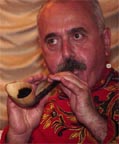|
|
|
|
|
|
|
|
|
|
|
|
|
|
|
|
|
|
|
|
July 14, 2002
Our first stop for the day in Moscow was Red Square, adjacent to the Kremlin where there are many famous buildings. It was our first encounter with overly persistent souvenir street vendors. |
|
|
Previous day |
|
|
|
|
|
|
|
 |
|
|
|
|
|
|
|
|
|
|
The crown jewel of these buildings is the outstanding St. Basil's Cathedral with its wonderful onion-shaped domes and vibrant colors. |
|
|
|
|
|
|
|
|
|
|
|
|
|
 |
|
|
We passed Christ the Savior Cathedral built (1839-1883) in memory of the Russian victory over Napoleon.
It was destroyed in December 5th, 1931 by Stalin and later a swiming pool opened on the site. In the 1990s donations from all over the country came in and the cathedral was rebuilt on the original site. A grandiose structure it can hold 10,000 people. |
|
|
|
The guards at Lenin's tomb were more relaxed than I expected. |
|
|
|
|
Our next stop was the famous Pushkin, Museum of Fine Arts.
Then, after a short trip to a bank for some roubles and some window shopping,we went to the city viewpoint on Sparrow Hills (formerly Lenin Hills) at Moscow State University. |
|
|
|
|
|
It was now mid afternoon and time for a whirlwind tour of the grandiose architectural masterpiece of the Stalinist era — the Moscow Metro. |
|
|
|
|
|
|
|
|
|
|
|
 |
|
|
|
|
In the evening, we had an opportunity to see a performance of the folk ensemble "Russian Patterns." There were many famous and very popular old Russian songs, many played with the conventional instruments (domra, mandolin, balalaika, accordion) The musicians performed traditional Russian instruments including the variety of so far unknown old instruments made by the musicians themselves: wind-horns, reed pipes, whistles, percussion instruments (rattles, drums, spoons, crackers.). Well-known singers of the Bolshoi Theatre and soloists of the Red Army Ensemble perform with this orchestra. |
|
|
|
|
|
Please note:- Most links are slide shows in Quicktime. A free player is available here  |
|
|
|
|
|
|
|
|
|
|
|
|
|
|
|
|
|
|
|
|
|
|
|
For background on:
|
|
|
|
|
|
|
|
|
|
|
|
|
|
|
|
|
|
|
Next day |
|
|


